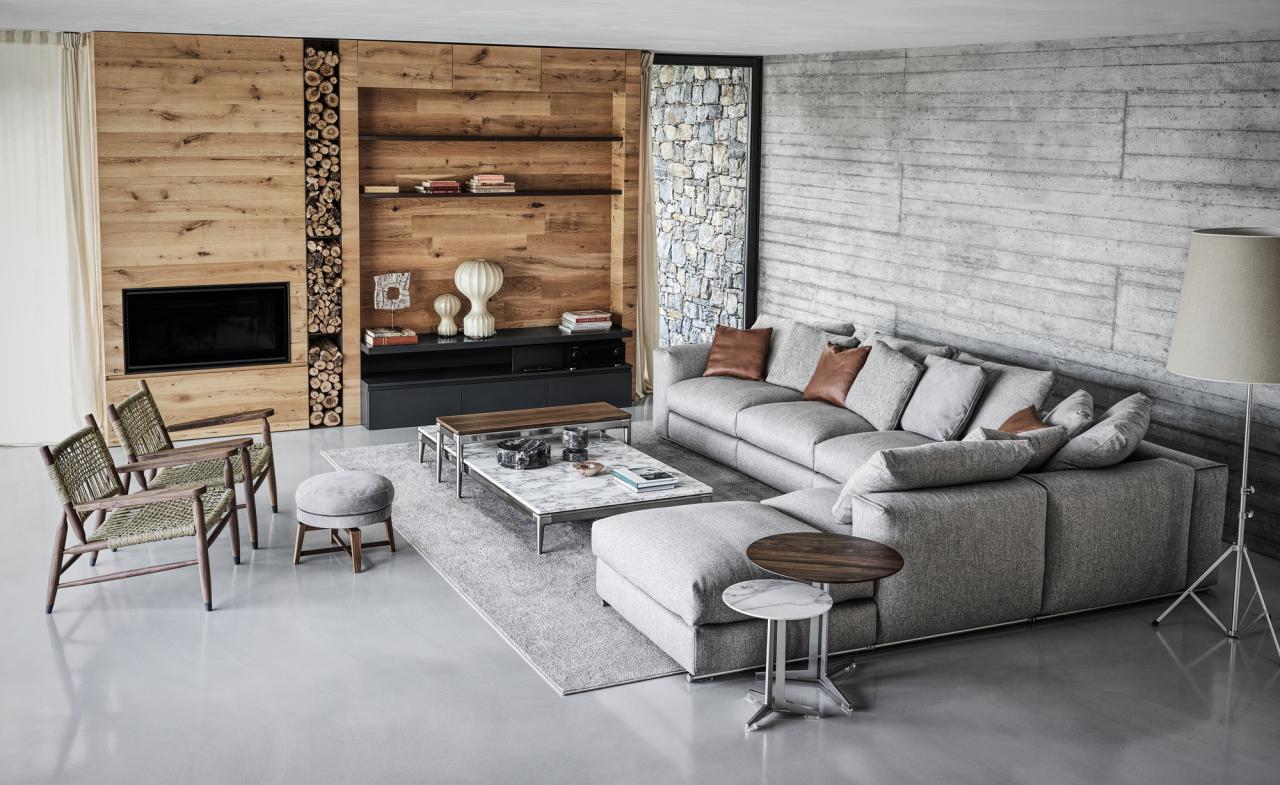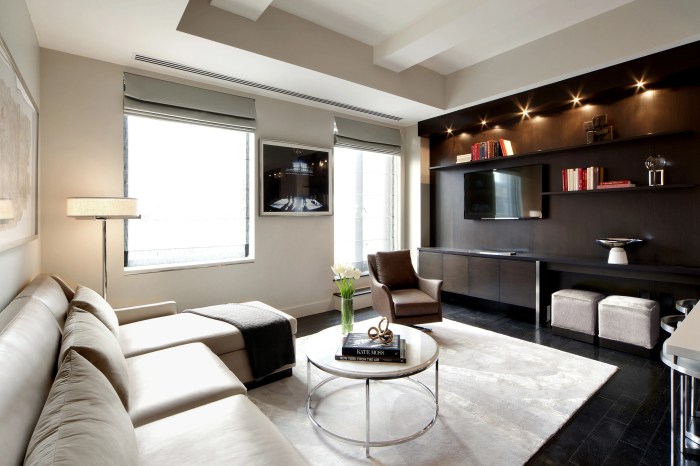Exploring the World of Interior Design Furniture
Step into the realm of interior design furniture where creativity meets functionality. From choosing the right pieces to understanding how materials impact style, this journey is filled with insights and inspiration.
Delve into the nuances of furniture types, materials, placement, and customization as we unravel the secrets to creating stunning interior spaces.
Types of Interior Design Furniture
When it comes to interior design, furniture plays a crucial role in defining the style and functionality of a space. There are various types of furniture that can be used to enhance different design aesthetics.
1. Sofas and Sectionals
Sofas and sectionals are essential pieces of furniture in any living room. They come in a variety of styles, sizes, and materials, making them versatile for different interior design themes. For example, a sleek leather sofa can add a modern touch to a contemporary living room, while a plush sectional with soft fabrics can create a cozy atmosphere in a traditional setting.
2. Dining Tables and Chairs
Dining tables and chairs are not only functional but also contribute to the overall look of a dining room. From elegant wooden tables with intricate carvings for a classic style to minimalist glass tables for a modern aesthetic, the choice of dining furniture can set the tone for the entire space.
3. Beds and Bedside Tables
In the bedroom, beds and bedside tables are key furniture pieces that can enhance the comfort and style of the room. Whether opting for a luxurious upholstered bed frame for a glamorous look or a sleek platform bed for a minimalist design, the selection of bedroom furniture can greatly impact the ambiance of the space.
4. Accent Chairs and Coffee Tables
Accent chairs and coffee tables are versatile pieces that can add personality and functionality to any room. From bold statement chairs to delicate glass coffee tables, these furniture items can complement the existing decor or serve as focal points in the design scheme.
5. Storage Cabinets and Shelving Units
Storage cabinets and shelving units are essential for keeping a space organized while adding visual interest. Whether opting for sleek built-in cabinets for a seamless look or open shelving units for a more airy feel, the choice of storage furniture can optimize both style and functionality in a room.
Materials Used in Interior Design Furniture
Materials play a crucial role in the construction of interior design furniture, impacting both the durability and style of the pieces. Different materials offer varying characteristics that cater to different needs and preferences.
Wood
Wood is a popular choice for furniture due to its natural beauty, warmth, and versatility. It can be crafted into various designs and finishes, making it suitable for classic, rustic, or modern styles. Wood furniture is durable and can last for generations with proper care.
Metal
Metal furniture is known for its sleek and contemporary look. It is often used in modern or industrial design styles. Metal furniture is durable, lightweight, and easy to maintain. It can add a touch of sophistication to any space.
Glass
Glass is commonly used in furniture design to create a sense of openness and lightness in a room. Glass furniture can make a space appear larger and more airy. While elegant, glass furniture requires regular cleaning to maintain its clarity and shine.
Other Materials
Other materials like plastic, leather, fabric, and rattan are also used in furniture design. Each material offers unique characteristics and aesthetics, catering to different design preferences and functional needs. It's essential to choose the right material based on the intended use and style of the furniture piece.
Furniture Placement and Layout

When it comes to interior design, furniture placement and layout play a crucial role in determining the functionality and aesthetics of a room. Properly arranging furniture can make a space feel more inviting, organized, and visually appealing. Here are some tips and principles to keep in mind when placing furniture in a room.
Principles of Furniture Layout
- Balance: Ensure there is a sense of equilibrium in the room by distributing the visual weight of furniture evenly.
- Scale: Choose furniture that fits the scale of the room to avoid overcrowding or making the space feel empty.
- Proportion: Consider the size of the furniture in relation to the room's dimensions to create a harmonious look.
Tips for Effective Furniture Placement
- Start with the focal point: Arrange furniture around a focal point, such as a fireplace or a large window, to establish a visual anchor.
- Allow for traffic flow: Ensure there is enough space for people to move around freely without obstacles.
- Create conversation areas: Arrange seating in a way that promotes interaction and communication among guests.
Furniture Arrangements for Different Room Sizes
| Room Size | Ideal Furniture Arrangement |
|---|---|
| Small Room | Opt for multi-functional furniture pieces and focus on maximizing vertical space to create the illusion of a larger room. |
| Medium Room | Consider creating zones within the room for different activities, such as a reading nook or a work area. |
| Large Room | Divide the space into different functional areas, such as a living area, dining area, and entertainment area, to make the room feel cozier. |
Custom vs. Ready-Made Furniture

When it comes to furnishing your space, you often have the option to choose between custom-designed furniture and ready-made pieces. Each option has its own set of benefits and drawbacks that can influence your decision-making process.Custom-designed furniture is crafted specifically to your preferences and requirements.
This means that you have more control over the design, size, materials, and overall aesthetic of the piece. On the other hand, ready-made furniture is mass-produced and readily available for purchase, often at a lower cost.
Quality
- Custom furniture is typically of higher quality as it is made with precision and attention to detail.
- Ready-made furniture may vary in quality, depending on the brand and materials used in its production.
Cost
- Custom furniture tends to be more expensive due to the personalized nature of the design and craftsmanship involved.
- Ready-made furniture is generally more affordable, making it a budget-friendly option for many consumers.
Uniqueness
- Custom furniture offers a unique and one-of-a-kind piece that reflects your individual style and taste.
- Ready-made furniture, while convenient, may lack the uniqueness and personal touch found in custom pieces.
Tailored Design Requirements
Custom furniture allows you to tailor the design to fit specific requirements such as size constraints, color preferences, and functionality needs. This level of customization ensures that the final piece seamlessly integrates into your space, enhancing both its aesthetic appeal and functionality.
Outcome Summary
As we conclude our exploration of interior design furniture, we hope you've gained valuable knowledge and ideas to enhance your living spaces. With the right furniture choices, every room can be transformed into a masterpiece of design and comfort.
FAQ Resource
How does furniture selection impact the overall design aesthetic?
Choosing the right furniture pieces can significantly influence the style and mood of a room. It can enhance the overall aesthetic or detract from it if not chosen carefully.
What are the benefits of custom-designed furniture over ready-made pieces?
Custom-designed furniture offers the advantage of being tailored to specific design requirements, ensuring a unique and personalized touch that ready-made pieces may lack.
What are the key principles to consider when placing furniture in a room?
Balance, scale, and proportion are essential principles to keep in mind when arranging furniture in a room. They help create a harmonious and visually appealing layout.